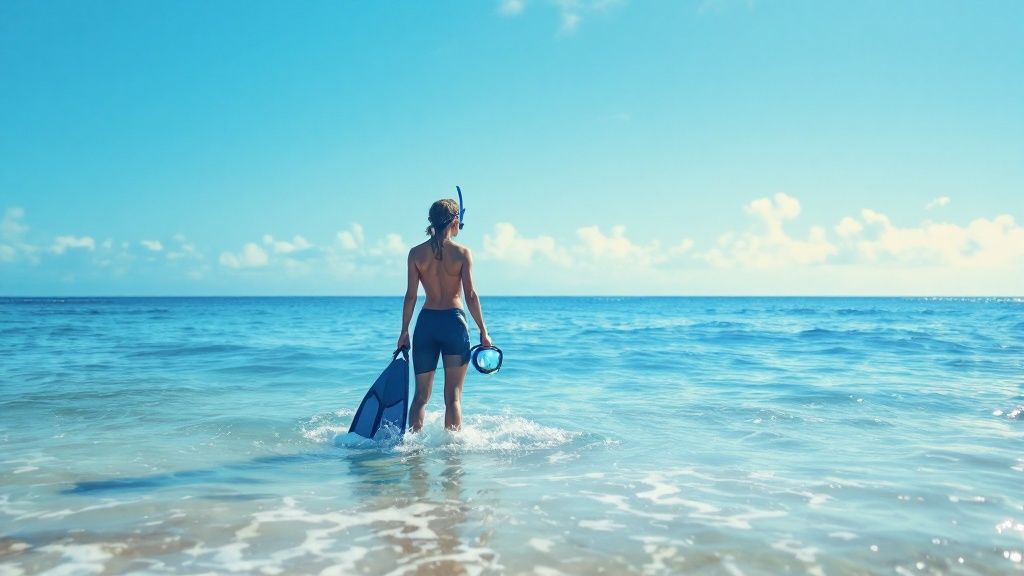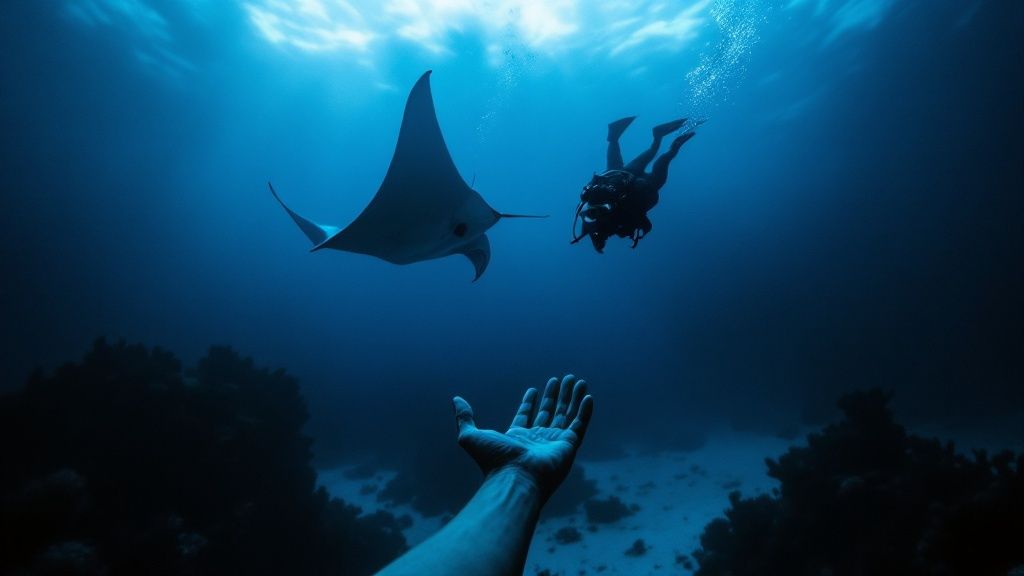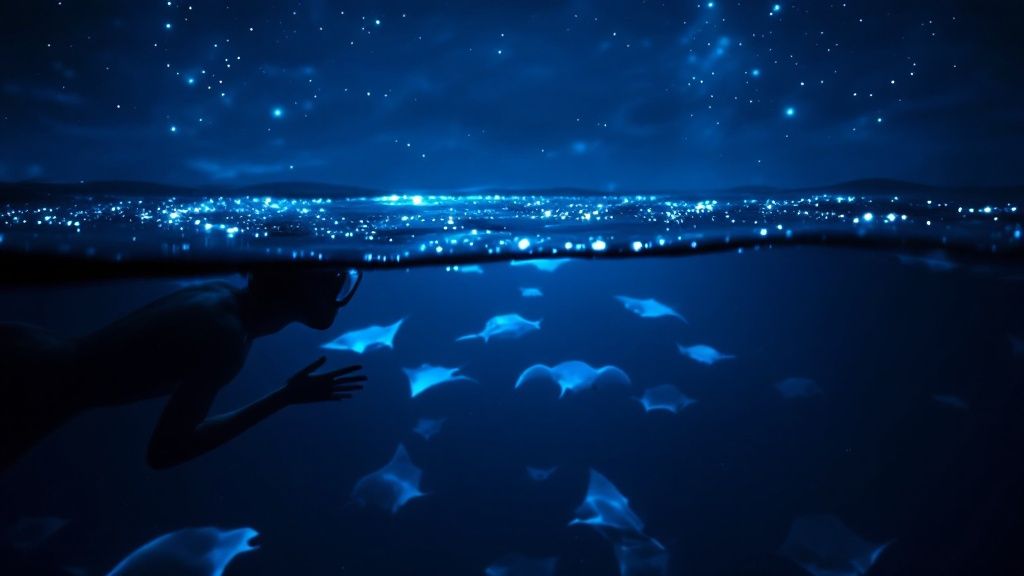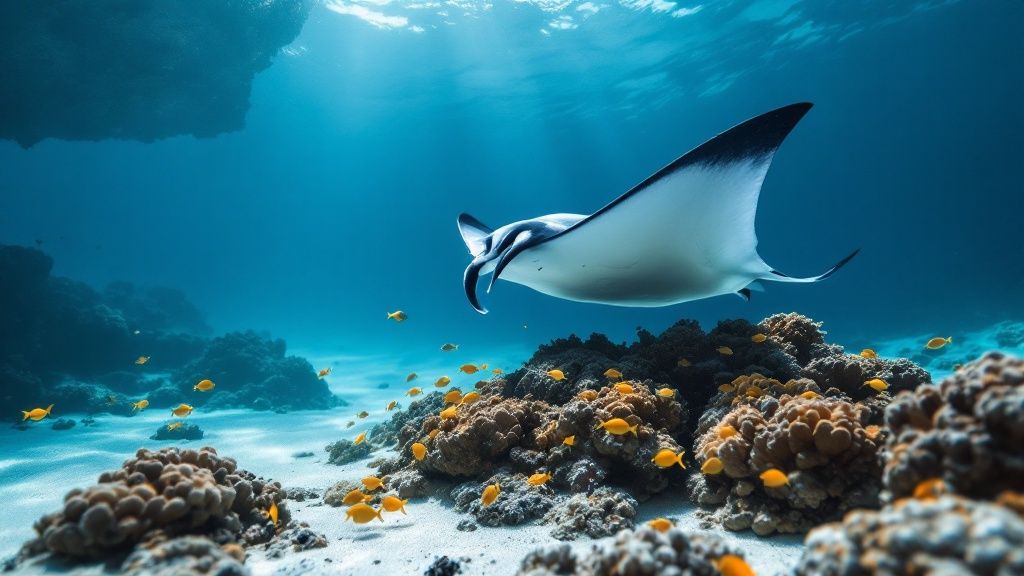Manta Ray Snorkel Kona: Top Tours & Experience Tips
- Byron
- May 26
- 11 min read
Why Kona's Manta Ray Encounters Are Absolutely Legendary

The Kona Coast of Hawaii offers a unique opportunity: snorkeling with manta rays. Witnessing these gentle giants in their natural habitat is more than just a typical snorkeling trip. It's an immersion into an underwater world where massive wingspans create a captivating ballet. But what exactly makes the Kona manta ray experience so special?
The Perfect Storm of Nature and Geography
The Kona Coast boasts a unique geographical advantage. The volcanic underwater landscape interacts with specific ocean currents. This creates nutrient-rich feeding grounds ideal for plankton, the manta ray's main food source. This abundance of plankton explains the high concentration of manta rays in the area. The gentle slopes and sandy bottom also provide the perfect environment for these graceful creatures to move effortlessly as they feed.
This natural food source is further amplified by the resort lighting along the coast. These lights, especially at designated viewing spots like Manta Village and Manta Heaven, attract even more plankton. They mimic a natural food source, creating a predictable feeding event that draws manta rays regularly. Unlike other locations where manta ray sightings are unpredictable, Kona provides consistently amazing encounters.
This consistency has made manta ray snorkeling off the Kona Coast world-famous. The area boasts exceptionally high sighting rates and established resident manta ray populations. According to tour operators, the average manta ray sighting success rate is between 80% and 90% year-round. This means 8 to 9 out of 10 snorkelers encounter manta rays during their trip. Find more detailed statistics here.
The Science Behind the Magic
Beyond the geographical benefits, several scientific factors enhance the Kona manta ray experience. Consistent water temperatures create a stable and comfortable habitat for the manta rays. Seasonal plankton blooms further increase the reliability of sightings, often aligning with peak tourist seasons. This combination of perfect conditions makes Kona the premier location for manta ray interactions, attracting both marine researchers and ocean enthusiasts.
A Cultural Connection
Manta rays hold deep cultural significance for native Hawaiians. They are often considered ocean guardians, symbolizing wisdom and grace. This reverence adds another dimension to the Kona manta ray experience. It connects visitors to the rich Hawaiian heritage while fostering a deeper appreciation for these incredible creatures. This cultural perspective, combined with the consistent sightings and unique underwater environment, transforms a simple snorkel trip into an unforgettable adventure.
Smart Planning For Your Bucket-List Manta Experience

Want to take your Kona manta ray snorkel adventure from "good" to "unforgettable"? It takes a bit of planning! Think about the key parts that can really make your experience amazing, like choosing the right tour and knowing how nature plays a role.
Choosing The Right Tour Operator
Finding a reputable tour operator is essential for a safe and enriching experience. Look for operators focused on both safety and conservation. A good tour operator will have certified guides, offer good equipment, and follow responsible wildlife viewing practices. Smaller groups often mean more personal attention and a better experience overall.
Understanding Manta Ray Activity
Manta rays come to Kona for the plentiful plankton. Learn more in our article about the best time to see manta rays in Kona. Knowing how the moon phases and ocean conditions affect plankton can improve your chances of a great sighting. For example, a full moon can make the lights used to attract plankton less effective, which could mean fewer manta rays.
Booking Strategies For Peak Season
Peak manta ray season usually happens during warmer months when there's more plankton. Booking your Kona manta ray snorkel tour ahead of time, especially during these busy periods, is crucial. This guarantees your spot and gives you more choices for the best day and time for your adventure.
Physical Preparation and Realistic Expectations
While snorkeling is generally easy to do, being moderately fit makes it even better. If you're comfortable in the water and can swim or float for a while, you'll enjoy the manta rays more without getting tired. Also, be realistic about water conditions and visibility. The ocean can be unpredictable, so being flexible with your plans can make unexpected changes into amazing memories.
Comparing Kona's Premier Manta Ray Snorkeling Locations

Each manta ray snorkel Kona site offers something unique. Knowing these differences helps you pick the right spot for your experience level and what you’re hoping to see. We'll compare Manta Village, near Garden Eel Cove, and Manta Heaven, in Keauhou Bay, looking at water conditions and the underwater environment.
Manta Village: Up Close and Personal With the Mantas
Manta Village, located in Keauhou Bay, is known for its shallow, sandy bottom and typically calm waters. This makes it great for all experience levels, especially beginners. The steady currents and the shape of the bay bring in nutrient-rich water. This attracts mantas with plenty of plankton to eat.
Often, you’ll see multiple mantas feeding at the same time. It's a truly amazing sight! However, this popularity can also mean larger crowds.
Manta Heaven: A Quieter Manta Ray Encounter
Manta Heaven, at Garden Eel Cove, offers a different experience. It's easily accessible by boat but usually has smaller crowds than Manta Village. This makes for a more personal manta ray encounter. The shallow depth and sandy bottom provide great visibility.
The plankton-attracting lights enhance the feeding activity, getting you up close to these gentle giants. Even if there are fewer mantas, the experience can be just as memorable.
To help you decide, we've put together a comparison table of the main snorkeling sites:
A detailed comparison of the main manta ray snorkeling locations including depth, accessibility, and unique features.
Site Name | Average Depth | Experience Level | Best Conditions | Unique Features |
|---|---|---|---|---|
Manta Village | Shallow | Beginner-friendly | Calm seas | High manta activity, can be crowded |
Manta Heaven | Shallow | All Levels | Calm seas | More intimate, fewer people |
Other Kona Sites | Varies | Varies | Varies | Secluded, research recommended |
As you can see, each location offers a slightly different experience. Choosing the right one will depend on your personal preferences.
Choosing the Right Snorkeling Site
So, how do you choose between Manta Village and Manta Heaven? Think about what kind of experience you want. Do you prefer a bustling atmosphere with potentially more manta rays, but also more people? Then Manta Village might be a good fit.
If a quieter, more personal encounter is your style, Manta Heaven might be better. Also, consider how comfortable you are in the water and how important a less crowded experience is to you.
Beyond the Well-Known Spots
While Manta Village and Manta Heaven are popular, other spots along the Kona coast offer unique opportunities. These less-visited locations are often more secluded, which can be appealing to experienced snorkelers or underwater photographers.
However, manta ray sightings at these locations can be less predictable. Doing some research beforehand is always a good idea.
What Influences Manta Ray Behavior?
Several factors affect where manta rays gather. These include the underwater terrain; mantas prefer sandy bottoms and gentle slopes. Current patterns, which distribute plankton, also play a key role.
Finally, cleaning stations, where small fish remove parasites from the mantas, can influence their location. Knowing these factors can enhance your manta ray snorkeling adventure.
What Actually Happens During Your Underwater Adventure

Stepping into the dark Pacific for a manta ray night snorkel in Kona, Hawaii is truly special. This section will give you a feel for what awaits you, from the first dip into the water to the breathtaking moment a manta ray glides overhead. Knowing what to expect can help you feel more comfortable and make the experience even more magical.
The Initial Descent and Settling In
After a briefing covering manta ray behavior and proper etiquette, you'll enter the water. You'll likely start near a floating platform equipped with lights. These lights attract plankton, the manta rays' main food source. The darkness might feel a bit strange at first. But as your eyes adjust, a captivating underwater world will start to appear. The lights act as a central point, illuminating the water and creating a surreal glow.
The Manta Ray Ballet Begins
As the plankton gathers, so do the manta rays. With their remarkable wingspans, sometimes exceeding 20 feet, they put on a captivating underwater show. Imagine graceful loops and barrel rolls, all while they feed on the microscopic organisms. This feeding activity, which frequently takes place just inches from the surface, offers an incredibly close view of these gentle giants. You'll be amazed by how close you are to these majestic creatures as they carry out their feeding routines.
Manta Ray Interactions and Etiquette
Manta rays are curious by nature and may approach snorkelers. It's essential to keep in mind, though, that these are wild animals. Touching them can interrupt their natural behavior and even harm their protective mucous layer. Keeping a respectful distance is essential for your safety and for the well-being of the mantas. For instance, resist the urge to reach out or swim alongside them. Instead, simply observe and enjoy their graceful movements. You may also find this helpful: our ultimate experience guide for manta ray night snorkeling in Kona.
The Underwater Light Show and Plankton Blooms
The underwater lights themselves create an amazing spectacle. Millions of tiny plankton, lit up by the beams, appear like a shimmering galaxy. This incredible light show, combined with the manta rays, provides a truly memorable experience. This otherworldly setting often leaves a deep impression on snorkelers.
Realistic Expectations and Water Conditions
While Kona is known for great visibility, conditions in the ocean can change. The ocean is inherently unpredictable, and visibility can be affected by things like the weather and currents. Being prepared for possible changes in water clarity will ensure a positive trip, no matter the conditions. This also means understanding the unpredictable nature of wildlife encounters. The number of manta rays present can differ from one night to the next.
The Massive Scale Behind Kona's Manta Ray Tourism Success
The Kona manta ray snorkel experience is a remarkable draw for tourists, far beyond a passing fad. Its popularity stems from the truly unique encounter it offers, creating a substantial industry around these gentle giants. Let's explore the magnitude of this success and its impact on the local economy and the manta rays.
Economic and Environmental Impact
Every year, tens of thousands of ocean enthusiasts travel to Kona specifically to encounter manta rays. Approximately 80,000 people participate in manta ray snorkeling tours along the Kona Coast annually. This makes it one of Hawaii's most popular marine wildlife experiences and a global example of successful marine tourism. Discover more insights about Kona manta ray tours. This influx of visitors significantly boosts Kona's economy, supporting businesses and creating jobs. However, this thriving industry requires responsible management.
Sustainable Practices for Future Encounters
Balancing access to wildlife with the protection of manta ray populations is essential. Sustainable tourism practices, such as limiting group sizes, are crucial to minimize disruption to the mantas' natural behavior. Educating visitors about responsible interactions ensures these creatures are treated with respect. This thoughtful approach protects the mantas and preserves the quality of the experience for future generations.
Understanding Visitor Demographics and Seasonal Patterns
Analyzing visitor demographics and seasonal patterns provides valuable data for managing this unique tourism sector. Understanding peak seasons helps operators adjust scheduling and resources, maintaining a balance between visitor demand and the well-being of the manta rays. Collaboration with marine biologists offers crucial insights into manta ray populations and behavior.
Collaborative Conservation Efforts
The tourism industry works closely with marine biologists to monitor and protect these gentle giants. This partnership safeguards the long-term health of the manta ray population while continuing to offer unforgettable experiences. The industry's commitment to sustainability encourages repeat visitors, reinforcing the value of responsible tourism and ensuring the continuation of these magical encounters.
The Science and Conservation Behind Your Manta Encounter
Behind every magical manta ray snorkel Kona experience lies a deep commitment to scientific research and conservation. This dedication not only makes these incredible encounters possible but also plays a vital role in protecting these gentle giants. Let's explore how scientists and tour operators work together to study and preserve these amazing creatures.
Tracking Manta Rays Through Photo Identification
Scientists and tour operators collaborate closely, tracking individual manta rays through innovative photo identification programs. Each manta ray possesses a unique pattern of spots on its underside, much like a human fingerprint. By photographing these distinct patterns, researchers can identify individual mantas, track their movements, and monitor their life histories. This data helps scientists understand population size, distribution, and individual behavior.
Monitoring Population Health and Maintaining Sustainable Tourism
This photo identification process is essential for monitoring the overall health of the manta ray population. It also provides crucial information for maintaining sustainable tourism practices. By understanding manta ray behavior and movement patterns, tour operators can refine their practices to minimize disturbance and maximize the positive impact of tourism. For example, knowing peak feeding times allows tours to be scheduled for minimal disruption.
Citizen Science: Your Contribution to Research
You, as a snorkeler, can become a citizen scientist and play an important role in ongoing research. By submitting photos of manta ray belly patterns, you contribute directly to the data pool, helping scientists expand their understanding of these animals. This collaborative effort accelerates research and deepens our knowledge of manta ray behavior and ecology. This knowledge, in turn, informs effective conservation strategies. Sighting statistics for manta rays along the Kona Coast have been meticulously tracked since at least 2009, allowing researchers and tour operators to identify trends, seasonal variations, and the overall health of the manta population. Find more detailed statistics here.
Conservation Challenges Faced by Manta Rays
Despite these research and conservation efforts, manta rays continue to face significant challenges. These include threats like entanglement in fishing gear and habitat degradation. By supporting responsible tour operators who prioritize conservation, you directly contribute to funding research and protection initiatives. Your manta ray snorkel Kona adventure becomes more than just a personal experience; it becomes an active contribution to the long-term survival of these magnificent creatures.
Making Your Manta Ray Adventure Absolutely Unforgettable
Your manta ray snorkel Kona adventure is bound to be amazing, but with a little preparation, you can make it truly unforgettable. This guide offers insider tips and practical strategies to elevate your underwater encounter, from capturing stunning photos to supporting ongoing conservation efforts.
Mastering Underwater Photography
Capturing the magic of these gentle giants requires a balance between getting the perfect shot and respecting the animals.
Invest in the right equipment: A waterproof camera or housing is essential. A red filter can enhance colors at depth.
Adjust your settings: Experiment with different ISO and shutter speeds for clear images in low-light conditions.
Respect the mantas: Avoid using flash, which can startle them. Maintain a respectful distance and never chase them.
Focus on composition: Use the "rule of thirds" to create dynamic images, and capture a variety of perspectives.
Check out our guide on manta ray snorkel Kona tips and best spots for more information about underwater photography.
Gear Up For Comfort and Safety
The right gear can significantly improve your snorkeling experience.
A well-fitting wetsuit: Even in warm water, a wetsuit provides warmth and protection, especially at night.
Mask and snorkel: Proper fit is key to prevent leaks and ensure clear vision. Use anti-fog solution.
Flotation device: A pool noodle or flotation vest provides extra buoyancy, reducing fatigue.
Reef-safe sunscreen: Protect your skin and the coral reef.
Mental Preparation For an Extraordinary Experience
Being in open water at night can feel unusual. Mental preparation can enhance your experience.
Visualize the encounter: Imagine the manta rays gliding through the water. This can ease anxiety.
Practice deep breathing: Slow, deep breaths can calm nerves and promote relaxation in the water.
Trust your guide: Your guide is there for your safety and to optimize your viewing experience.
Extending Your Manta Ray Adventure
The magic doesn't have to end with the tour.
Daytime snorkeling: Explore Kona's reefs during the day.
Marine life education centers: Learn more about manta rays and the local ecosystem.
Support conservation efforts: Donate to organizations protecting manta rays and their habitat.
Share your experience: Inspire others by sharing your photos and stories.
To help you prepare, we've created a handy checklist:
Essential Manta Ray Snorkeling Preparation Guide
Category | Essential Items | Optional Upgrades | Pro Tips |
|---|---|---|---|
Gear | Wetsuit, mask, snorkel | Underwater camera | Ensure a proper fit for all your gear. |
Skills | Basic swimming ability | Comfortable in open water | Practice snorkeling beforehand. |
Expectations | Respectful observation | Seeing multiple manta rays | Remember, wildlife encounters can vary. |
This table summarizes the key items and skills you'll need for a successful and enjoyable manta ray snorkeling trip. While seeing multiple manta rays is a possibility, remember that wildlife encounters are unpredictable.
Ready for an unforgettable manta ray experience in Kona? Book your adventure with Manta Ray Night Snorkel Hawaii today!
Comments